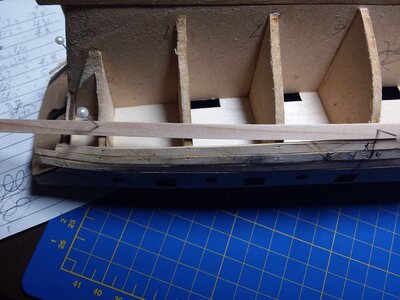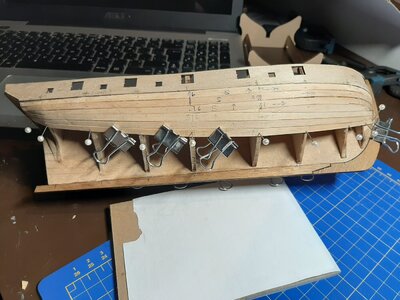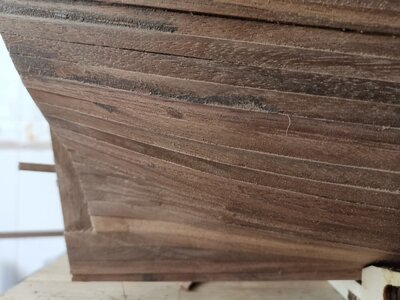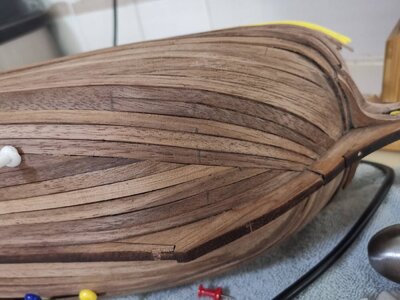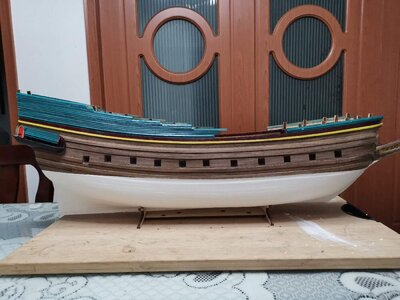I found the third plank to bea beast to put in place. I can see the problem is that the forward end of the plank has to be bent upward to come to the edge of the second plank, which forcrd the free edge of plank 3 to tend to pop outwards. At the same time, the foremost bulkhead, no.2, starts to pinch in (as shown in the sketch below). Leon says to check after about 5 planks to see if the bottom edge of the fifth plank needs trimming to match a straight edge. I will have to do that now, after 3. I can salvage what I have with filler and sanding I think, but I need to make a straighter line to proceed with. The bottom of the bulwark yo start with has a fair bit of sheer so even the first plank needed to be bent slightly up at each end.
Now I need advice on a question of plank tapering. In the sketch below, with planks that average 5.1mm wide, and a mid ships bulkhead edge length of 66mm, I need about 13 planks. At the bow, station 2, with only a 46 or 47 mm edge length, those 13 planks need to be tapered to 3.5mm. Fair enough.
At the each bulkhead, he says to include the deadwood in the total edge length. In that case, 9 is 68 mm, and 10 is 78mm, so we will need wedges. But for reasons not apparent to me, Leon included only the 37mm edge length for station 10, that is the length from bottom of bulwark to top of deadwood. So the planks at the stern taper to 2.9mm or so. As a newbie, I accepted that with some puzzlement, but it seems to me the more I go that the planks will be too narrow at the stern and should maybe be full width. Otherwise I taper them, but don't force them together and fill with stealers as needed. Even so, the math for a 2.9mm tapered plank width at the stern doesn't seem right. I am 99% sure I am following Leon's method. He spends more time explaining the bow taper and says "and we do the same for the stern", but later mentions that we are taking 2.1 mm from the stern plank, so 5-2.1 = 2.9.
Help would be welcome.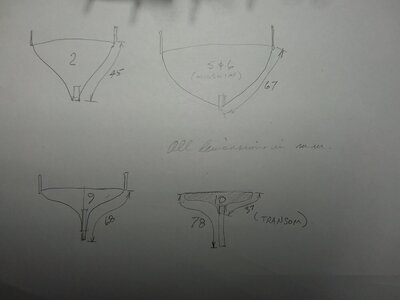
Now I need advice on a question of plank tapering. In the sketch below, with planks that average 5.1mm wide, and a mid ships bulkhead edge length of 66mm, I need about 13 planks. At the bow, station 2, with only a 46 or 47 mm edge length, those 13 planks need to be tapered to 3.5mm. Fair enough.
At the each bulkhead, he says to include the deadwood in the total edge length. In that case, 9 is 68 mm, and 10 is 78mm, so we will need wedges. But for reasons not apparent to me, Leon included only the 37mm edge length for station 10, that is the length from bottom of bulwark to top of deadwood. So the planks at the stern taper to 2.9mm or so. As a newbie, I accepted that with some puzzlement, but it seems to me the more I go that the planks will be too narrow at the stern and should maybe be full width. Otherwise I taper them, but don't force them together and fill with stealers as needed. Even so, the math for a 2.9mm tapered plank width at the stern doesn't seem right. I am 99% sure I am following Leon's method. He spends more time explaining the bow taper and says "and we do the same for the stern", but later mentions that we are taking 2.1 mm from the stern plank, so 5-2.1 = 2.9.
Help would be welcome.






